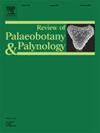Enhancing dinoflagellate cyst classification through combined LM and SEM analysis: A reassessment of Spiniferites magnificus and Fibradinium annetorpense
IF 1.7
3区 地球科学
Q2 PALEONTOLOGY
引用次数: 0
Abstract
Scanning Electron Microscopy (SEM) is underutilized in the taxonomic study of fossil dinoflagellate cysts, which are predominantly described through Light Microscopy (LM). However, SEM can complement LM by revealing detailed morphological features, such as ornamentation and perforations, that are often obscured under LM alone. This study applies the “single-grain method,” combining LM and SEM, to refine the taxonomic descriptions of Spiniferites magnificus and Fibradinium annetorpense. SEM observations revealed previously undocumented features in S. magnificus, including variable intergonal processes, perforated sutural crests, and robust trifurcate gonal processes. These findings refine its taxonomy and suggest environmental influences, such as salinity variations, on its morphological variability. Similarly, SEM analyses of F. annetorpense allowed the determination of the cyst tabulation and clarified the previous described fibrous outer wall structure as the result of continuous ridges and indentations across the crests formed at the edge of each paraplate. This has also highlighted the presence of nano sized indentations forming rings around the paraplates.
Both species hold significant biostratigraphic value. Spiniferites magnificus serves as a key marker for the Late Danian in the North Sea Basin, with its extinction and inception coinciding with critical regional biozones. Fibradinium annetorpense has a wider stratigraphic range with reported occurrences from the Late Cretaceous to the Thanetian, but the specimens analyzed in this study are from upper Danian sediments collected in western Greenland.
结合LM和SEM分析加强鞭毛囊肿的分类:细刺虫和羊膜纤维虫的再评估
扫描电子显微镜(SEM)在化石鞭毛藻囊肿的分类研究中未得到充分利用,这主要是通过光学显微镜(LM)来描述的。然而,扫描电镜可以通过揭示详细的形态学特征来补充LM,例如纹饰和穿孔,这些特征通常在单独的LM下被掩盖。本研究采用LM和SEM相结合的“单粒方法”,对细尖刺虫(Spiniferites magnificus)和细尖刺虫(Fibradinium annetorpense)进行了分类描述。扫描电镜观察揭示了以前未记载的特征,包括可变的间突、穿孔的缝合线嵴和坚固的三叉形突。这些发现完善了其分类,并表明环境影响,如盐度变化,对其形态变异。类似地,对F. anetorpense的扫描电镜分析可以确定囊肿的排列,并澄清了前面描述的纤维外壁结构,这是由于在每个伞形板边缘形成的波峰上连续的脊和凹痕造成的。这也突出了在伞形板周围形成环的纳米级压痕的存在。这两个物种都具有重要的生物地层学价值。华丽尖刺石是北海盆地大年晚期的一个重要标志,其灭绝和开始与关键的区域生物带相吻合。据报道,纤维adinium annetorpense的地层范围较广,从晚白垩纪到Thanetian都有发现,但本研究分析的标本来自格陵兰岛西部收集的大年纪上部沉积物。
本文章由计算机程序翻译,如有差异,请以英文原文为准。
求助全文
约1分钟内获得全文
求助全文
来源期刊
CiteScore
3.50
自引率
21.10%
发文量
149
审稿时长
6 months
期刊介绍:
The Review of Palaeobotany and Palynology is an international journal for articles in all fields of palaeobotany and palynology dealing with all groups, ranging from marine palynomorphs to higher land plants. Original contributions and comprehensive review papers should appeal to an international audience. Typical topics include but are not restricted to systematics, evolution, palaeobiology, palaeoecology, biostratigraphy, biochronology, palaeoclimatology, paleogeography, taphonomy, palaeoenvironmental reconstructions, vegetation history, and practical applications of palaeobotany and palynology, e.g. in coal and petroleum geology and archaeology. The journal especially encourages the publication of articles in which palaeobotany and palynology are applied for solving fundamental geological and biological problems as well as innovative and interdisciplinary approaches.

 求助内容:
求助内容: 应助结果提醒方式:
应助结果提醒方式:


